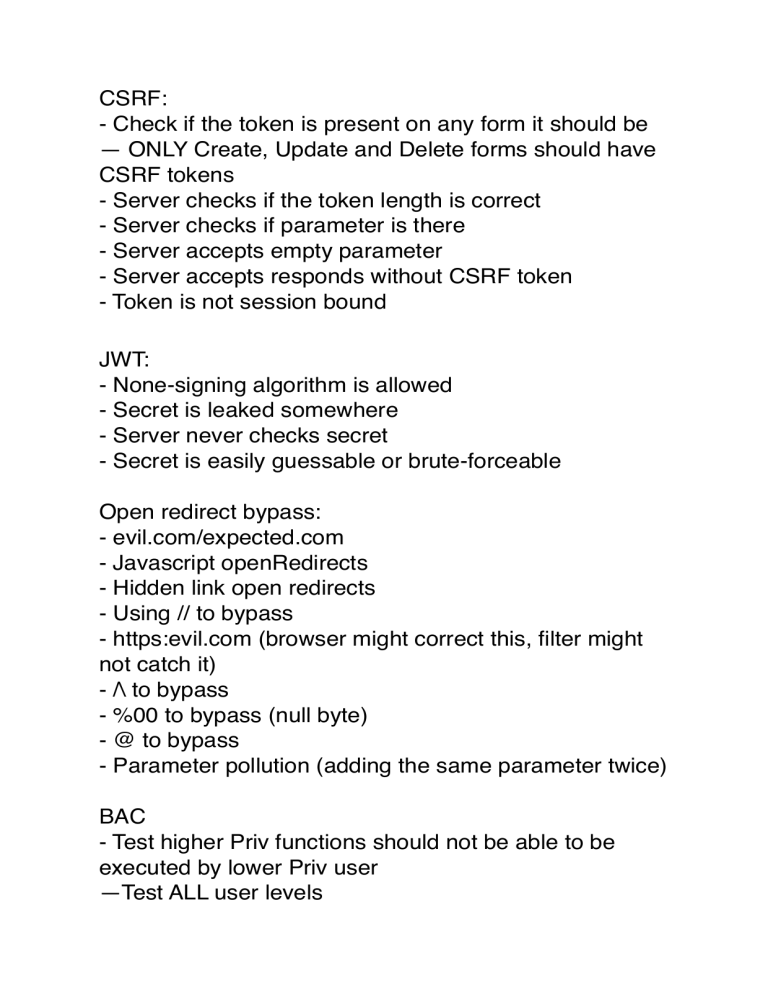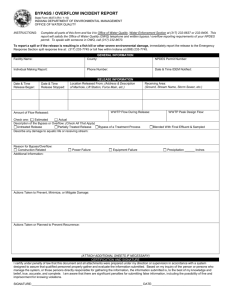
CSRF:
- Check if the token is present on any form it should be
— ONLY Create, Update and Delete forms should have
CSRF tokens
- Server checks if the token length is correct
- Server checks if parameter is there
- Server accepts empty parameter
- Server accepts responds without CSRF token
- Token is not session bound
JWT:
- None-signing algorithm is allowed
- Secret is leaked somewhere
- Server never checks secret
- Secret is easily guessable or brute-forceable
Open redirect bypass:
- evil.com/expected.com
- Javascript openRedirects
- Hidden link open redirects
- Using // to bypass
- https:evil.com (browser might correct this, filter might
not catch it)
- /\ to bypass
- %00 to bypass (null byte)
- @ to bypass
- Parameter pollution (adding the same parameter twice)
BAC
- Test higher Priv functions should not be able to be
executed by lower Priv user
—Test ALL user levels
— Test with authorise
— JS Functions via developer console
— Copy and paste of URL
IDOR
- Test between ALL tenants (companies hosted on one
server/database. Can also be divisions of companies)
— Test with authorise
— JS Functions via developer console
— Copy and paste of URL
Captcha bypasses
- Try change request method
- Remove the captcha param from the request
- leave param empty
- Fill in random value
LFI
- Using // to bypass
- /\ to bypass
- \\
- %00 to bypass (null byte)
- @ to bypass
- URL encoding
- double encodings
RFI:
- Using // to bypass
- /\ to bypass
- \\
- %00 to bypass (null byte)
- @ to bypass
- URL encoding
- double encodings
SQLi:
- ‘“ to trigger
— SQLmap
XXE:
- SVG files (images), DOCX/XLSX, SOAP, anything
XML that renders
- Blind SSRF, file exfiltration, command exec
Template injections (CSTI/SST)
- ${7*7}
- If resolves, what templating engine
- Try exploit by looking at manuals
— URL encode special chars ({}*)
— HTML entities
— Double encodings
XSS:
- ‘“`><img src=x> into every input field, the moment you
register and start using the application
- Enter a random value into every parameter and look for
reflection
- See what context reflection is in
- Craft attack vector based on context
— JS
— HTML
— HTML tag attribute
—…
— Url encode
— HTML entities
— Capital letters
— BASE64 encode payload
- CSP might be active
— Try bypasses
— See what is active and where script can be gotten from
— Encode them in base64
— Mascarade script as data
SSRF
- SSRF against server itself
- SSRF against other servers on the network
Command injection
- Test every single parameter
- Make a list of commands + command separators for
target OS
Admin panel bypass
- Try referr header
- Easy username/pass
- Directory brute forcing for unprotected pages


